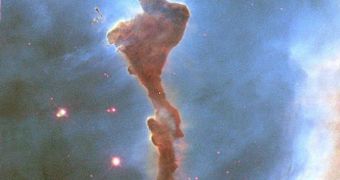Giant molecular clouds make up an extremely small portion of the interstellar medium, and yet they are mainly responsible for the creation of massive numbers of new stars. Recently, astronomers learned that these enormous structures can be destroyed by the very stars they create.
The study determined that light emitted from these stars can disperse the molecular clouds, preventing them from condensing, and thus creating new stars. This is interesting because the clouds can reach tens of parsecs in diameter.
They permeate galaxies, more so in younger ones. In old galaxies, the only way for molecular clouds to come together is if two of the cosmic behemoths collide with each other. This reactivates the dead stellar nurseries, causing hydrogen gas to stir again.
However, as new stars form, the radiation they emit eventually contributes to dispersing the cloud, providing a natural control mechanism for the birth of new stars. These effects are not caused by supernova alone, but also by regular stars.
“Even before a single star explodes as a supernova, massive stars carve out huge bubbles and limit the star formation rates in galaxies,” say researchers Dr. Elizabeth Harper-Clark and professor Norman Murra, who are based at the Canadian Institute for Theoretical Astrophysics (CITA).
“In particular, the stars within a GMC can disrupt their host and consequently quench further star formation.” Harper-Clark explains, adding that star formation rates are controlled by the mass of stars already produced by a stellar nursery.
“Indeed, observations show that our own galaxy, the Milky Way, contains GMC [giant molecular clouds] with extensive expanding bubbles but without supernova remnants, indicating that the GMC are being disrupted before any supernovae occur,” the expert adds.
According to a new series of computer simulations, it would appear that light can clear up stellar nurseries because the momentum photons have is translated to the surrounding material when the elementary particles are absorbed.
Since these photons always push away from their sources – the stars emitting them – they continue to push hydrogen gas away, out of the stellar nursery. The combined effects of multiple stars are way too much for the molecular cloud to handle.
“These momentum transfers add up, always pushing away from the light source, and produce the most significant effect, according to these simulations,” the researchers conclude, quoted by Daily Galaxy.

 14 DAY TRIAL //
14 DAY TRIAL //